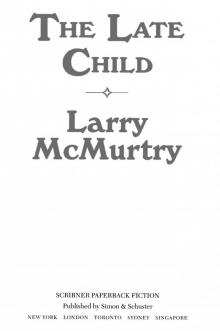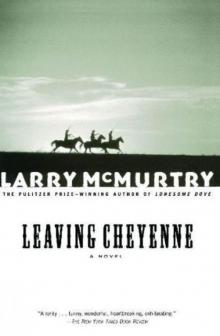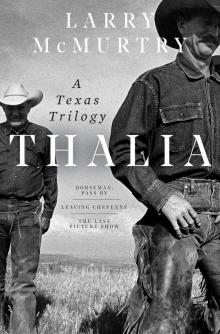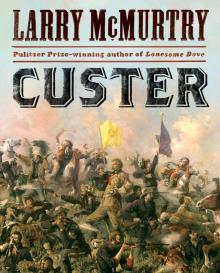- Home
- Larry McMurtry
The Colonel and Little Missie Page 6
The Colonel and Little Missie Read online
Page 6
Cody served a little more than a year and a half with the Seventh Kansas. On mustering out he was still a private. There is no evidence that he ever acquired much interest in military protocol, and he seems to have had even less interest in military training. What he had to offer the army—any army—was his knowledge of the country; he knew how to get from here to there, and could usually do so even if hostilities were in progress.
Though he liked to brag a little about his lunch with General Marmaduke, Cody was not vainglorious about his soldiering—and the same could be said for his Indian fighting. Frequently he would remark of a particular skirmish or chase that, really, it didn’t amount to much—in these instances he was truthful. Many short engagements didn’t amount to much.
Cody, who could be quite specific about details if he chose to be, could never quite remember actually enlisting in the Seventh Kansas. In Leavenworth, after his mother’s death, he
entered upon a dissolute and reckless life—to my shame, be it said—and associated with gamblers, drunkards, and bad characters generally. I continued my dissipation about two months and was become a very hard case—I met quite a number of my old comrades and neighbors, who tried to enduce me to enlist and go south with them. I had no intention of doing anything of the kind; but one day, after having been under the influence of bad whiskey, I awoke to find myself a soldier in the Seventh Kansas.
He enlisted in February of 1864, which was rather late in the war. But for the bad whiskey he might never have enlisted at all.
7
BECAUSE Bill Cody, by the standards of our time, started work so young, and because the highlighted episodes—what I have called the tropes—so much dominate the story of his fame, it’s easy to forget that the narrative of his life is one story and the narrative of his fame another.
When Cody obliviously enlisted in the Seventh Kansas he was only eighteen. He had quit the Pony Express in 1861 and was for a time at loose ends, rather in the manner of teenagers everywhere. Cody just happened to be a good deal more experienced than most teenagers would have been. When he was thirteen his mother actually got him to go to school for two months, the longest period of instruction he ever suffered.
This brief educational interlude ended when the Colorado gold rush caused gold fever to flare up across the nation. It was Pikes Peak or bust for many an American youth. Cody rushed off west with some friends, none of whom knew the slightest thing about mining. Very soon they were bust. Fortunately Cody ran into a wagon master he had worked for previously; once again he found himself a teamster, working his way home.
It was about this time that Mrs. Cody turned the Cody home into a hotel, a short-lived effort. The few guests she could lure in were mostly just her son’s friends, Wild Bill Hickok among them.
Mining having failed, young Cody next turned to trapping, partnering with Dave Harrington, who had briefly been one of his lively sister Julia’s suitors. This was in 1859, just before his Pony Express job. The beaver boom had ended some decades previously, mainly because the beaver themselves were more or less ended—though there were still a few rich pockets of these valuable rodents. Probably there was a good deal of nostalgia in the Cody-Harrington expedition—yearning of a sort that sometimes seizes thirteen-year-olds. It gave the boys a chance to feel that they were actually of the mountain man generation, which they may have fantasized about much as young cowboys will still fantasize about having been trail drivers. Cody idolized Kit Carson and was probably seeking at least a taste of Carson’s experience.
At any rate Cody and Harrington were soon trapping the Republican River, in Colorado. Though they had an ox team and abundant supplies, luck did not attend their efforts. One ox slipped on some ice, dislocated a hip, and had to be shot. Then a bear attacked the other ox. Cody managed to shoot the bear, but then he too slipped on the ice and broke his leg. Harrington set the leg but winter was upon them. They made a fairly snug dugout in the side of a hill, after which it was decided that Harrington should leave Cody and go for help. They reckoned that he could probably make the necessary round trip in about three weeks, but bad weather intervened and it was twenty-nine days before Cody saw Dave Harrington again.
Cody had abundant supplies—at least he did for a while—and weathered the interval well enough but for one close call, a visit by a party of Sioux who were on the prowl. Probably they would have made short work of this boy had it not been for the fortunate intervention of a Sioux elder Cody had happened to meet at Fort Laramie during one of his hauls.
The Sioux elder was old Rain in the Face, who—at least as the trope has it—intervened and persuaded the hostile warriors to spare the young man’s life. The warriors submitted grudgingly. They took Cody’s guns and the lion’s share of his provisions, but they didn’t kill him.
Dime-novelish as this story sounds, it was more than likely true. The young trappers were in a country thick with Sioux, and a leader, or at least an elder, named Rain in the Face did exist. His son, young Rain in the Face, fought in the Battle of the Little Bighorn and, for a time, claimed to have fired the shot that killed Custer. This claim is no longer given much credit. Sitting Bull pointed out that everyone was shooting at Custer (though his body bore only two bullet wounds).
In his book Cody expresses considerable annoyance at the Indians for making free with his possessions, though they could readily have made just as free with his life. Being saved by old Rain in the Face made a good tableau in the Wild West shows, but the incident, assuming it happened, was actually one of Cody’s narrowest escapes—if the old Sioux hadn’t remembered him, or if he had just chosen to stay in his lodge that day, it is doubtful that there would have been many legends of Buffalo Bill.
8
THERE was one significant aspect of his life that Buffalo Bill Cody could never convert into a trope or reduce to a playlet in his Wild West shows, and that was his long, mostly turbulent marriage to Louisa Frederici, a comely St. Louis girl of French descent. In her youth Lulu was both very attractive and very spirited.
The two were introduced by Lulu’s cousins in a somewhat awkward way. Cody and the cousin walked in, found Lulu dozing over a book, and promptly jerked the chair out from under her—Cody never quite determined the right way to approach women. Louisa, meaning to slap her cousin, slapped Cody instead. Since Louisa had a date that evening with a gentleman she didn’t really want to see, she persuaded Cody to stick around and help her pretend that she and Cody were engaged.
According to Louisa, this auspicious meeting occurred in May 1865.
Forty years later, when he was trying unsuccessfully to divorce Lulu, Cody had this to say about the mock engagement: “Boylike, I thought it very smart to be engaged. I asked her to marry me, or asked her if she would marry me if I would come back after the war was over. And jokingly she said yes.”
If the engagement really began in May of 1865, then of course the war was over, though Cody, who had never been much interested in the war, may not have taken in this fact. Cody was on the move, as usual, and claimed to be a little surprised when he got home to Leavenworth and found several letters from Lulu, asking him to keep his word. Perhaps surprisingly, he did keep his word. In the divorce proceedings in 1905 he tried to pretend he was tricked into a marriage he never wanted, but a passage in the autobiography was there to trip him up: “I returned to St. Louis, having made up my mind to capture the heart of Miss Frederici, whom I adored above any young lady I had ever seen.”
Louisa’s heart was captured, and the two were very soon married, but it was not long before Louisa had an inkling that the ruse of their engagement may have chased off the wrong suitor. Just as the boat was pulling out, to take the honeymooners upriver to Leavenworth, a gang of ruffians rushed at them. Someone had recognized Cody from his jayhawking days and proposed to hang him then and there, an impulse Louisa soon came to sympathize with. Accustomed from birth to the amenities of the old French Quarter in St. Louis, she was unprepared for the amenityless vi
llage that Leavenworth then was. She was also unprepared for Bill’s rough acquaintances, some sixty of whom were at the dock with a brass band when their boat pulled in, eager to perform a kind of prairie charivari, a practice that probably came as a big shock to the gently bred Louisa.
This is not to say that Louisa Cody lacked the fighting spirit; where Bill Cody was concerned she could more than take up for herself—when she could catch him, that is. But Bill, true to his nature, was usually on the move. At one point he guided General Sherman, then commander of the Division of the Mississippi, from Fort Riley to Fort Kearny—much later Sherman thanked him by giving him a blurb for his Wild West show. It’s a safe guess that Cody’s thoughts turned none too often to the young bride he had left at home in Leavenworth.
Louisa had nothing of the pioneer in her. She missed city pleasures and city ways. And she missed her husband. If Bill Cody had at least stayed home to fight with her she might have stuck it out in Leavenworth, but with him gone most of the time and their first child coming, she, sensibly, took herself back to St. Louis. Bill Cody accepted this move as nonchalantly as he had accepted the end of the Civil War. He liked St. Louis himself—the prairie just happened to be the place where he made his living.
Children came, riches came, mistresses came—some of them very expensive mistresses, such as the actress Katherine Clemmons, whose meager talent Cody spent some $80,000 promoting—but Louisa was still his wife, housed at first in tents and barracks, then later in grand houses in North Platte, Nebraska, or Rochester, New York, but not very happy in any of the above. The boy they took in, Dan Muller, loved Louisa and wrote poignantly of the sadness he felt when she informed him that she could no longer live with Uncle Bill. Yet the union, despite Bill’s strange attempt to end it in its fortieth year (when Louisa revealed her jealousy of Queen Victoria), remained somehow a marriage.
In writing about two other classically difficult marriages—those of the Carlyles and the Tolstoys—the critic V. S. Pritchett spoke of these tightly bound yet eternally warring couples as “the professionals of marriage.” But the Carlyles and the Tolstoys faced their difficulties in lockstep, under the same roof, whereas Louisa’s principal difficulty was in keeping Bill home for any length of time. When old Count Tolstoy finally wandered off from Yasnaya Polyana, he left a venerable, long-established country seat. Bill Cody had no such seat, although he built several great piles that might have served as one had he been a settled person. But he had grown up as a virtual nomad on the wild free prairies and it was a liking for the nomad’s life, rather than a dislike of his wife, that kept him on the move. For most of his life he made his living through nomadic pursuits, and this didn’t really change when he became an impresario. The shows still had to move. And Cody had to move. It is doubtful that he could have stayed put for a whole year even if there was a big stipend to be earned.
Louisa soon learned to be practical in her abandonment. As soon as Cody had money he began to buy property; at least he would if he could close a deal before he squandered the money. When she saw this pattern emerging Louisa soon developed a rather good head for business, which, in this case, meant seeing that all of the property was put in her name, a fact Cody didn’t notice until he ran into financial difficulties in the eighties and nineties.
Bill and Louisa’s fights were on a par with the Tolstoys’—many were as ridiculous as any farce ever staged, but like most marital fights, they were only funny if one happened to be a spectator, not a player. Bill Cody was never really indifferent to Lulu; their children came and there were times when he recovered his early affection for her, but it didn’t keep him from being gone a lot, leaving a restless woman stuck on the lonely plains.
In their fifty-one years of marriage it is doubtful that Cody was home even for six months at a stretch. He missed births—he even missed deaths. They were together so irregularly that they never fully got used to one another—every time Bill came home there would have to be an awkward period of readjustment to their domestic state. At the very end, after all the fights, all the mistresses, all the long estrangements, were the war-worn Codys glad that they had one another still?
The question is hard to answer because no biographer with much psychological acuteness has troubled to look hard at the Cody marriage. The complexities of Bill’s career really overshadowed it. In 1920, three years after Cody’s death, Lulu wrote a little memoir with the help of Courtney Ryley Cooper, Annie Oakley’s first biographer. It’s a readable effort, though with some massive gaps and a good deal of vagueness and imprecision. Lulu Cody had lived in North Platte, Nebraska, for some thirty-five years and yet seemed to believe that the town and also Bill’s ranch were close to the Wyoming line. They weren’t.
The source most likely to tell the reader what Lulu Cody’s life was like is a book by the diminutive (four foot eight) but vigorous Nebraska historian Nellie Snyder Yost. Her book is called Buffalo Bill: His Family, Friends, Fame, Failures, and Fortunes—it’s not as good on Cody himself as the books by Don Russell and Joy Kasson, but it’s much better than either of those on the Codys’ home life, to the extent that they had one.
Nellie Snyder Yost had the advantage of living on the spot—North Platte, Nebraska—where much of the Codys’ domestic life took place. She knew several Codys, and of course heard many tales. To this day Buffalo Bill is a huge presence in North Platte—in a way he’s the only presence, even now. Nellie Yost has done her best to separate truth from rumor, something that becomes harder and harder to do as the years pass. I doubt that she’s one hundred percent successful—no biographer is—but she comes a good deal closer than either Bill or Lulu has done. Somehow she gets the feel of what the prairie scout and his often left at home wife really felt about one another.
Lulu Cody’s book, Memories of Buffalo Bill by His Wife, is interesting in part because of what it leaves out. Annie Oakley is never mentioned and neither is Katherine Clemmons or any of the six old girlfriends who showed up at Cody’s funeral. On the page, at least, Lulu finally had Bill Cody to herself.
9
FROM 1857, when he began to work for Russell, Majors, and Waddell, William F. Cody could fairly be described as an able all-round plainsman. He could drive teams, he could cowboy, he was a sought-after courier, he was a more than competent hunter as well as an organizer of hunts. He could fight Indians if required, although he clearly preferred to live and let live where the Indians were concerned. But when the Civil War ended he was still a youth, essentially unestablished, just one more mustered-out private.
Then along came the dime novelist Ned Buntline, who sensed a different potential for Bill Cody. It was Buntline who first nudged Cody toward what would become a brilliant career as a showman, a career that would occupy him during the second half of his life.
His fame as Buffalo Bill, however, was forged on the plains, during the half decade between 1866 and 1871, when Cody, without exactly pushing himself, managed to receive major publicity for what looks now to have been a very minor role in the almost constant Indian wars that were fought on the great plains during these critical years.
A word of background may be helpful.
When the Civil War finally ended America was a war-weary nation. A few years of peace would not have been amiss, and yet, only in the industrial Northeast was there much peace. The South was soon engulfed in the struggles of Reconstruction, and in the West there were a goodly number of very warlike tribes who were by this time awake to the fact that their way of life was under serious threat.
A few privileged Indian leaders—Red Cloud, Spotted Tail, Sitting Bull, and others—thanks to the government’s shrewd policy of bringing such leaders east, to show them the majesty of Washington and New York, with perhaps a visit to the president thrown in, knew that what lay ahead for their people was more in the nature of a promise than a threat: but a deadly promise it was, as Red Cloud recognized. Late in his life he remarked that the whites had made many promises, more than he could remember, b
ut they had only kept one. They said they would take the Indians’ land, and they took it.
Sitting Bull, after coming to Washington and meeting with President Cleveland, recognized immediately that there was really no hope. The Indians would have to do what the white men wanted them to do, and live where they wanted them to live, or the Indians would die.
Even if every Indian killed a white man with every step he took, Sitting Bull said, it would change nothing. The whites were too many, the Indians too few; besides which, the whites had better weapons.
Still, no matter how clear their insight, or how grave their doubts about the future, the Plains Indians were warrior societies, and they were defending homelands and long-held traditions which they loved. So they were going to fight. They were warriors, it was their country, they knew it better than even the best white scouts; for a time there would be wholesale war.
The white soldier with perhaps the clearest strategic vision where the Indians were concerned was General William Tecumseh Sherman, who shortly after the Civil War ended was made commander of the Department of the Mississippi. Sherman’s way of fighting impressed itself on the nation in his great, deadly march to the sea. War was hell; the more brutal it could be made, the quicker it would be over.
In the settled South there was no escape, if one happened to be in Sherman’s path.

 Terms of Endearment
Terms of Endearment Some Can Whistle
Some Can Whistle All My Friends Are Going to Be Strangers
All My Friends Are Going to Be Strangers Lonesome Dove
Lonesome Dove Crazy Horse: A Life
Crazy Horse: A Life Comanche Moon
Comanche Moon Cadillac Jack
Cadillac Jack Streets of Laredo
Streets of Laredo Duane's Depressed
Duane's Depressed The Late Child
The Late Child Texasville
Texasville Rhino Ranch
Rhino Ranch Pretty Boy Floyd
Pretty Boy Floyd Telegraph Days
Telegraph Days The Evening Star
The Evening Star The Last Kind Words Saloon
The Last Kind Words Saloon Buffalo Girls
Buffalo Girls Horseman, Pass By
Horseman, Pass By Boone's Lick
Boone's Lick Leaving Cheyenne
Leaving Cheyenne Sin Killer
Sin Killer The Lonesome Dove Chronicles (1-4)
The Lonesome Dove Chronicles (1-4) The Desert Rose
The Desert Rose Moving On
Moving On Dead Man's Walk
Dead Man's Walk The Last Picture Show
The Last Picture Show When the Light Goes
When the Light Goes Streets Of Laredo ld-2
Streets Of Laredo ld-2 Thalia
Thalia Crazy Horse
Crazy Horse Oh What a Slaughter
Oh What a Slaughter The Colonel and Little Missie
The Colonel and Little Missie Zeke and Ned
Zeke and Ned Telegraph Days: A Novel
Telegraph Days: A Novel The Last Kind Words Saloon: A Novel
The Last Kind Words Saloon: A Novel Comanche Moon ld-4
Comanche Moon ld-4 The Berrybender Narratives
The Berrybender Narratives Custer
Custer